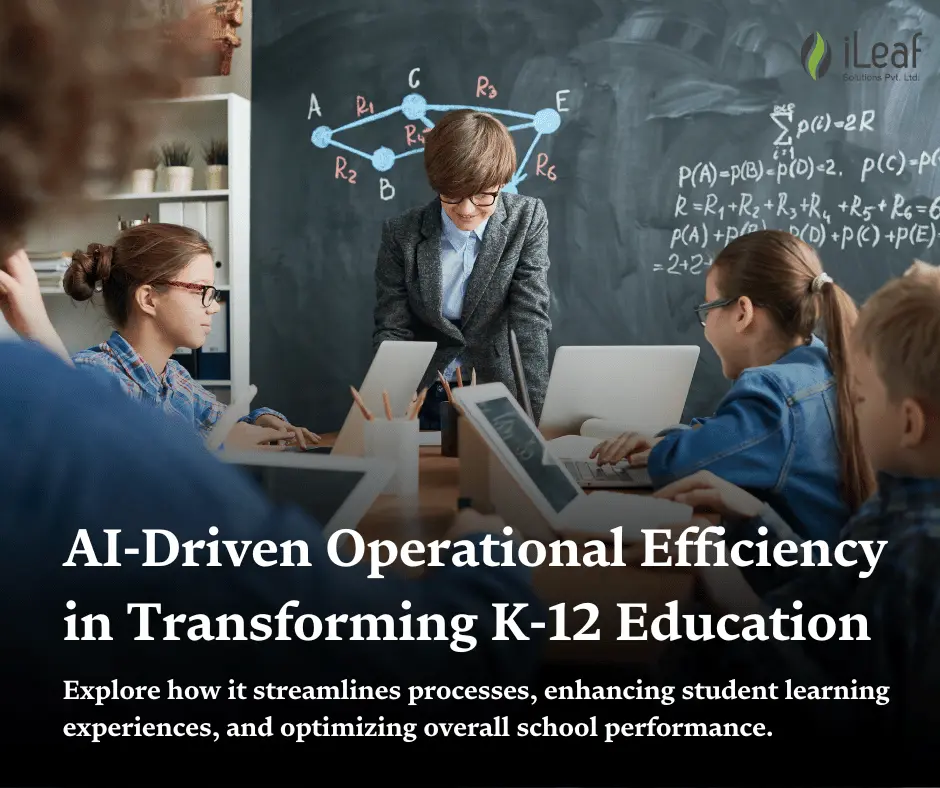AI-Driven Operational Efficiency: The First Step in Transforming K-12 Education

Overview
- Introduction
- Understanding AI-Driven Operational Efficiency
- Exploring Key Applications of AI in K-12 Education
- Addressing Challenges to Successful AI Integration in Schools
- Fostering Positive Attitudes Towards AI Adoption Among Educators
- Equipping Educators with the Skills They Need to Thrive in an AI-Driven Future
- Conclusion: Embracing the Transformative Potential of AI in K-12 Education while Addressing Barriers to Adoption
Introduction
AI has entered every other sector at a very fast pace and has changed the way we work and live. Education is no exception. From improving student outcomes to operational efficiency, schools look at AI-driven solutions as strong tools that can help them perform better in these two key areas. This article explores the importance of AI-driven operational efficiency in K-12 education, covering areas of applications, benefits, challenges, and strategies for successful implementation.
Understanding AI-Driven Operational Efficiency
AI-driven operational efficiency in K-12 education refers to how the employment of AI technologies could better organize general administrative tasks, enhance decision-making processes, and uplift the overall performance of educational organizations. By automating routine activities and informing data-driven insights, AI allows educators to free more time for them to engage in core teaching and student support.
Exploring Key Applications of AI in K-12 Education
- Personalized Learning: AI algorithms can analyze student data to identify individual learning styles, strengths, and weaknesses. This enables teachers to tailor instruction to meet the specific needs of each student, fostering a more engaging and effective learning experience.
- Intelligent Tutoring Systems: AI-powered tutoring systems can provide personalized guidance and support to students, helping them to grasp complex concepts and develop problem-solving skills.
- Administrative Automation: AI can automate administrative tasks such as grading, attendance tracking, and scheduling, reducing the administrative burden on teachers and staff.

- Predictive Analytics: AI will analyze complex datasets for patterns and trends that help the schools predict future outcomes and make reasoned decisions on resource allocation and curriculum development.
- Smart Content Creation: AI will be able to create customized learning materials such as quizzes, worksheets, and lesson plans according to the data of the students' performances and curriculum standards.
Addressing Challenges to Successful AI Integration in Schools
While AI offers significant benefits, its implementation in K-12 education can present challenges. Some key concerns include:
- Data Privacy and Security: Schools must ensure that student data is collected, stored, and used ethically and securely.
- Teacher Resistance: Some educators may be hesitant to adopt new technologies or may lack the skills to effectively use AI tools.
- Cost: Implementing AI solutions can require significant upfront investment, which may be a barrier for some schools.
- Technical Infrastructure: Schools may need to upgrade their IT infrastructure to support AI applications.
Fostering Positive Attitudes Towards AI Adoption Among Educators
To overcome resistance to AI adoption, schools should:
- Provide Professional Development: Offer training and workshops to help educators understand the benefits of AI and learn how to use AI tools effectively.
- Encourage Experimentation: Create opportunities for educators to explore and experiment with AI applications in their classrooms.
- Highlight Success Stories: Share examples of how other schools have successfully implemented AI to improve student outcomes and operational efficiency.
Equipping Educators with the Skills They Need to Thrive in an AI-Driven Future
Educators must develop a strong foundation in digital literacy and AI. This includes:
- Data interpretation and presentation: Knowledge about the whole process of data collection, analysis, and interpretation through which this data can be used to make decisions and inform teaching.

- AI Tool Proficiency: The method of sending out information, teachers often ask for, usually also includes correcting test papers and written assignments manually. At the same time, the task becomes high-tech. Using AI systems can help them automatically grade the texts without any teacher intervention.
- Ethical Considerations: Awareness of the ethical issues surrounding AI in education is crucial, such as confidentiality and bias.
Conclusion: Embracing the Transformative Potential of AI in K-12 Education while Addressing Barriers to Adoption
In terms of its potential to enhance student learning experiences, reduce administrative costs for schools, and spur innovation, AI-driven operational efficiency is the game-changing technology in K-12 education. A solution lies in the problems associated with education and the application of professional development in schools. To make use of the AI technology in the best possible way, the schools should exist in a world of making both equity and efficiency possible.














